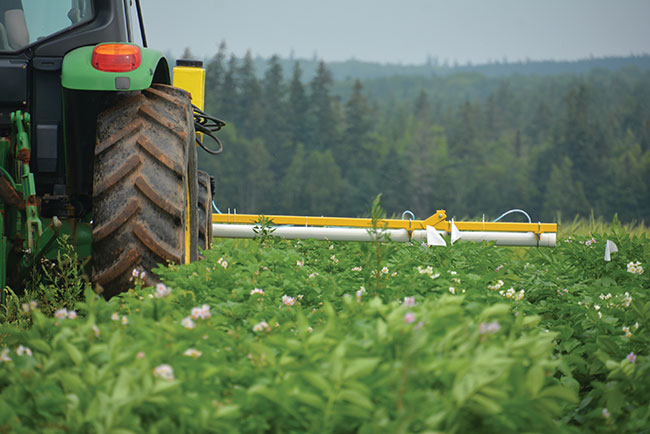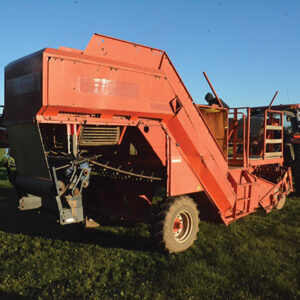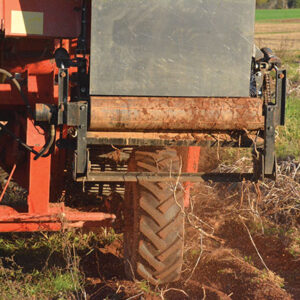
Features
Weed Control
Left uncontrolled, weeds would cost P.E.I. producers millions: study
What is the potential impact of uncontrolled weeds on potato yields?
April 12, 2024 By Julienne Isaacs
 Andrew McKenzie-Gopsill and his team at the Agriculture and Agri-Food Canada’s Charlottetown Research and Development Centre have been looking at the threat of weed impact on potato crops. Whether it’s “crop topping” or the vine crusher, McKenzie-Gopsill says limiting weed seeds in the seedbank is key to minimizing weed pressure.
Photos Courtesy of Andrew McKenzie-Gopsill.
Andrew McKenzie-Gopsill and his team at the Agriculture and Agri-Food Canada’s Charlottetown Research and Development Centre have been looking at the threat of weed impact on potato crops. Whether it’s “crop topping” or the vine crusher, McKenzie-Gopsill says limiting weed seeds in the seedbank is key to minimizing weed pressure.
Photos Courtesy of Andrew McKenzie-Gopsill. It’s an academic question – no potato producer would risk failing to control weeds that might affect productivity. But it’s an essential question because it provides a baseline understanding of the threat posed by weed pressure.
It’s also the topic of a research paper published in March 2023 by a team of Canadian and U.S. weed scientists. Titled “Potential potato yield loss from weed interference in the United States and Canada,” the paper compiles data from studies conducted between 2000 and 2018 to assess the impact of weed interference on yield.
According to Andrew McKenzie-Gopsill, a research scientist and weed specialist based at Agriculture and Agri-Food Canada’s Charlottetown Research and Development Centre, even though weeds “are always there, they are not always front-of-mind for producers.”
McKenzie-Gopsill is part of the Canadian Weed Science Society, which is in turn a member of the Weed Science Society of America (WSSA). The WSSA’s Weed Loss Committee is systematically examining the impacts of uncontrolled weeds across crop types, he says. Along with weed scientists Peter Sikkema and Nadir Soltani at the University of Guelph, McKenzie-Gopsill helped gather data for the review on potato weed research.
“We’re trying to determine the impact [of weeds]. It gives us a good justification [for] and shows us the importance of weed management,” says McKenzie-Gopsill.
Further, the authors of the paper write, the research underscores the importance of integrated potato weed management in research programs in Canada and the U.S.
Study design and results
Researchers and extension specialists in both countries were contacted to provide data on yield loss due to weed interference, says McKenzie-Gopsill.
To qualify for the study, experiments had to include a weed-free control with greater than 95 per cent weed control, to demonstrate maximum productivity in a weed-free environment, as well as a “weedy” control where no weed control methods were applied.
“Potential yield loss for each state and province was calculated as a percentage of yield lost for each individual study, which was averaged within each year, and then averaged across the period for which data was available,” the authors of the study write.
Regional potato production data and commodity prices for the years of the study were collected from USDA and AAFC reports; the estimated potato yield loss due to weeds was then multiplied by the mean potato price from 2000 to 2018 to find the potential monetary loss in each region.
Canadian data was limited to Prince Edward Island, from studies conducted between 2000 and 2006, as well as 2018.
The study found that potential potato yield loss from weed interference on P.E.I. was estimated at 26 per cent, which translates to a potential monetary loss of US$13 million.
In the United States, the picture was even bleaker. “Nationally, in the United States, if no weed management tactics were implemented in potato there would be an estimated potato yield loss of 45 per cent, an annual yield loss of 9.1 billion kg and a farm-gate loss of US$465 million,” the authors of the paper write.
- McKenzie-Gopsill says limiting weed seeds in the seedbank by using tools like the vine crusher is key to minimizing weed pressure.
New weed management tactics
In Canada, herbicide-resistant weeds are a major concern when it comes to thinking about weed control in potato. McKenzie-Gopsill says research completed in 2018 and 2019 found that 50 per cent of surveyed fields on P.E.I. have metribuzin resistant weed populations. His research team is continuously reviewing newer data, and their findings are consistent with that 50 per cent figure, he says.
But it’s not just resistance that can create problems for producers. Pre-emergent herbicides are activated with moisture; in a very dry year, potatoes must be cultivated to incorporate herbicides into the soil, where they can be activated by residual soil moisture, or irrigated.
A large component of McKenzie-Gopsill’s work at AAFC Charlottetown is focused on sustainable integrated weed management in potato.
His program focuses on seedbank management techniques aimed at keeping weed seeds in the seedbank to a minimum.
One technique, used in-season, is “crop-topping,” which encompasses any weed control technique applied above the crop. For example, a wick bar or “weed wiper,” basically a sponge soaked in herbicide, might be pulled over the field where it deposits the herbicide on weeds rising above the potato canopy; alternatively, this can be done with a mower or electric weed zapper.
McKenzie-Gopsill and his colleagues have also experimented with a suite of techniques known as “harvest weed seed control,” or HWSC, including harvest weed seed destruction using a weed seed crusher mounted on a combine.
They’ve also worked extensively on cover crop species and management as a weed control tactic.
“If you have annual cover crops, you can mow a couple of times per season and interrupt that [weed] lifecycle. Conversely, you have grasses that are tolerant of mowing – if you have some of these annual cover crops, we do quite a bit of tillage; there will be soil prep at the start of the season, [when the cover crop] is terminated and then tilled,” says McKenzie-Gopsill.
The research is ongoing, but McKenzie-Gopsill says it’s helpful to think about weed control in potato from the standpoint of minimizing weed seeds in the seedbank.
“Anything we can do to limit the seeds that are viable and return to the seedbank minimizes weed pressure in potato,” he says.
Print this page

